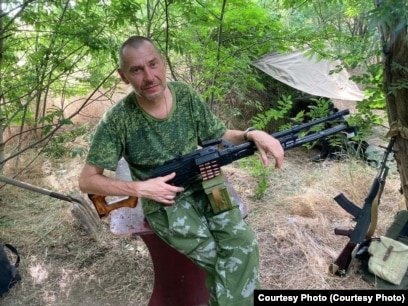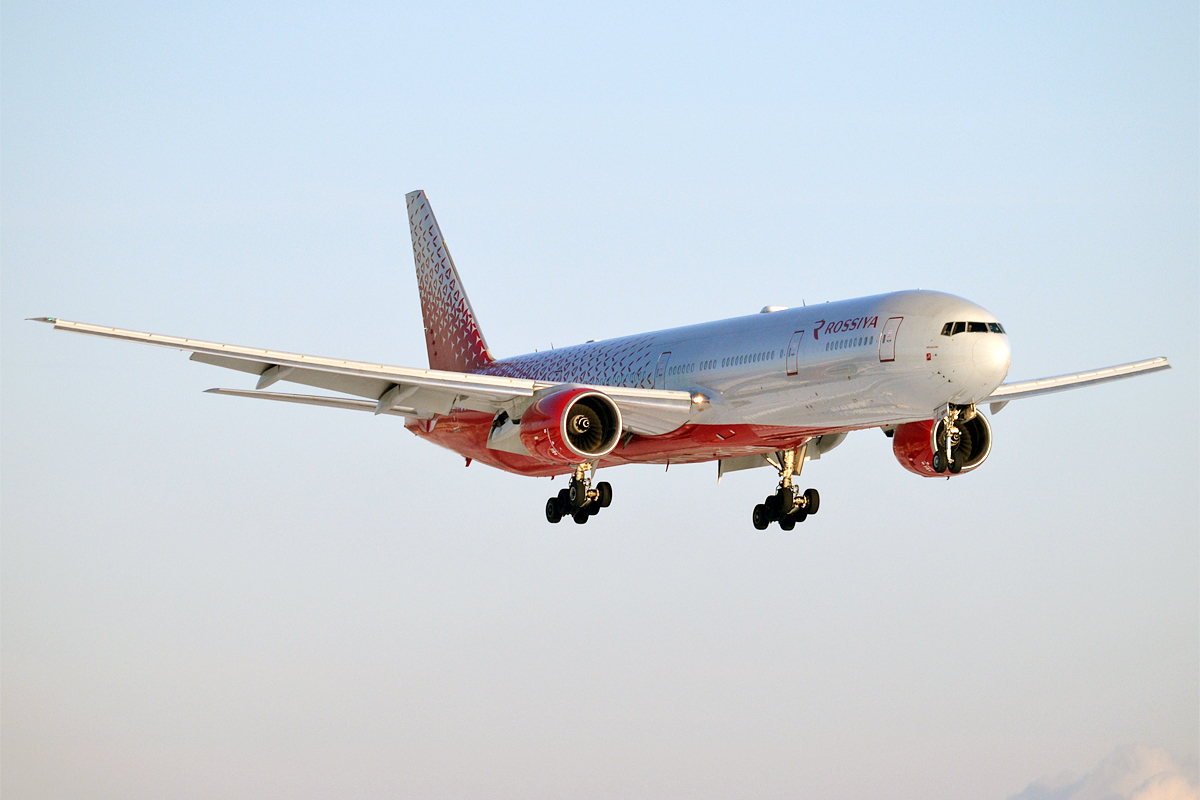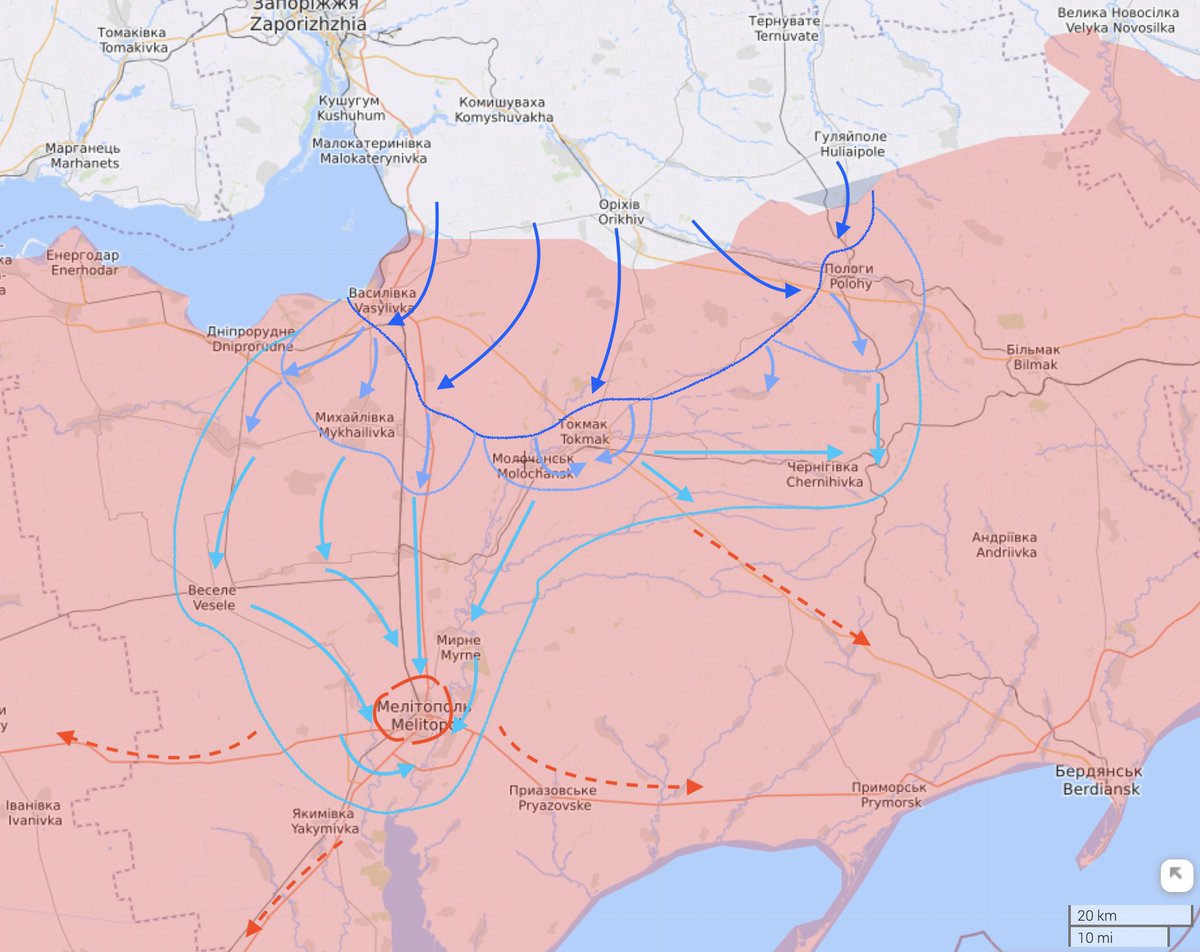1/ This is a continuation of a translation of @IanMatveev's thread on the geographical and military considerations of a possible Ukrainian offensive in the south. For the first part, see here:
https://twitter.com/ChrisO_wiki/status/1653143818814857216
2/ From @IanMatveev:
Part 4 - the beginning of the breakthrough
It is most advantageous to start a breakthrough in 3-4 directions at once, and on each also in several separate areas, to then develop those that will go well.
Part 4 - the beginning of the breakthrough
It is most advantageous to start a breakthrough in 3-4 directions at once, and on each also in several separate areas, to then develop those that will go well.
3/ How to choose a place for the breakthrough? This is influenced by two factors – the weakness of enemy defences and tactical expediency. They often conflict with each other.
4/ After all, all important targets are well covered, and the weak defence is there, from which then you will not be able to get out on your own. So there has to be a compromise.
5/ The Russian army is surely building the densest defences in the major population centres, so it is a good thing none of those are directly on the front lines. But in any case, it is not a good idea to break through via villages and hamlets, getting into street battles.
6/ I think the AFU will try to break through immediately along the main roads, bypassing and isolating the fortifications in the settlements. 

7/ The main forces can be thrown into the attack in the direction of Novoprokopovka-Solodka Balka-Tokmak, to cut the attack zone into two parts from the beginning.
8/ An interesting option is a breakthrough through Nesterianka and Myrne to Tavria and Novohorivka to reach the highway to Tokmak and on to Molochansk to the southeast. If we can't get through Vasylivka, an attack on Novohorivka will open the road to the E105 highway as well.
9/ Another direction will be the road southwest of Polohy, it is like a backdoor – it allows us to get close to the rear of the dense chain of settlements from Novokarlivka to Kins'ki Rozdory. Potentially a very interesting direction that could derail the Russian defences.
10/ For example, a breakthrough here would allow the AFU to go to Berdiansk – if the attack on the left flank will choke. Naturally, a direct attack on Polohy with a breakthrough near Dorozhnyanka is also possible. Then there would be an offensive from two sides at once.
11/ Obviously a breakthrough will be required near Kamianske, with an offensive on Vasylivka. I suspect that this will be the most difficult – the Russian troops can concentrate large forces here in a narrow area. Vasylivka's importance is obvious, so Putin's units will fight.
12/ Now let's come down to earth and think about what the AFU can do to break through the defence. They will face obstacles such as:
1. Mines
2. trenches and fortified points
3. artillery fire
4. Physical obstacles (pyramids, ditches, rivers, ravines)
5. Air strikes
1. Mines
2. trenches and fortified points
3. artillery fire
4. Physical obstacles (pyramids, ditches, rivers, ravines)
5. Air strikes
15/ Possible tactics may be as follows. Before the attack, artillery shells the defence line. The goal is to destroy physical fortifications like pyramids, complicate the position of the defenders of the first line in the trenches, possibly suppress some of the firing points.
16/ Then early in the morning the bomb squad and anti-personnel drones should operate simultaneously. The UAVs distract the enemy, causing light damage, but mostly forcing them to press into the ground. And doing detailed reconnaissance at the same time.
17/ For example, by identifying ATGMs, buried tanks acting as firing points, forward depots and supply roads, light mortars, and anything else important. Meanwhile, sappers quickly make gaps in the first line of minefields.
18/ The leading tanks go through the breaches in the minefields, covering the following BMPs and wheeled armoured vehicles with their armour. It is possible that tanks with mine flails will go straight ahead. Slower but more reliable.
19/ The goal is to cut through the first line as quickly as possible, even if some equipment is lost. Having created a gap, the infantry group, supported by some tanks, should start flanking the first line of trenches to widen the breakthrough area. And the leading units advance.
20/ During such an attack the AFU will lose some equipment – mostly to mines and as a result of APC and RPG shots from the trenches. But tanks are unlikely to be destroyed – only damaged and then repaired.
21/ The use of mobile artillery (122mm self-propelled artillery, mortars, and 105mm light cannons) that can work as quickly as possible on demand by advancing infantry will be important.
22/ Russian artillery and MLRS fire can be a serious problem. It is important to deprive it of its strength while preparing for an attack. Long-range batteries, such as HIMARS, CAESARs, and Pzh-2000s should be allocated for counter-battery fire.
23/ I don't think aviation would play a significant role in the breakout phase, unless the Ukrainian columns moving out to attack would come under attack. It is important to cover them.
24/ Russian Su-25s would fire unguided rockets over the area and the Su-34s would drop bombs, but their accuracy would be very poor. And they will not fly close to the front.
25/ For the Ukrainian Air Force, the priority targets will be artillery batteries that open fire on the advancing troops. But don't expect big results here either. Several air battles will probably ensue.
26/ Helicopters would be much more effective. Evacuation of the wounded, delivery of supplies and advance teams, minor equipment such as communications systems, will all be handled by Mi-8s, Mi-17s and Mi-24s. 

27/ Another option, though unlikely to be the main one, is the gradual attrition of the defences. Regular bombardment, exhaustion with drones and gradual removal of mines, perhaps even at night (although it is extremely difficult) on some forgotten section of the front.
28/ The aim would be to maximally weaken the defences there, so that small assault groups could try to occupy the first strip of trenches. And then, under the cover of these forces, conduct a full-fledged mine clearance and break through with heavy equipment.
29/ Judging by videos from the front, the lines of the Russian trenches are not overcrowded – there are often only 3-4 soldiers per 100 meters of trench. So attritional tactics might work, given the mess in Russian units and poor control of the situation.
30/ Part 5 - key points
I call key points the population centres whose control will play an important role in the Ukrainian counterattack. Roughly speaking, if the Ukrainian army liberates and occupies all of the following settlements and villages, the offensive will succeed.
I call key points the population centres whose control will play an important role in the Ukrainian counterattack. Roughly speaking, if the Ukrainian army liberates and occupies all of the following settlements and villages, the offensive will succeed.

31/ I did not include Tokmak and Melitopol – it is too obvious that they are key. Moreover, even some of their districts and parts may be key. But here we are talking about another level of analysis – we will deal with it when the AFU starts fighting for these cities.
32/ So, I have divided the key points by direction. First, the western flank - Vasylivka, Mikhailivka and Vesele. Matviivka can also be listed here. All of these points open the road to the south and then to the east (highway T0818 - T0811). 

33/ Vasylivka with the nearby Pidhirne is the most important settlement that opens the road to Melitopol. It will have to be liberated without any doubts, probably it is here that the heaviest battles of the first phase – on the breakthrough of the AFU – will be launched.
34/ Next is Mikhailivka. The fortification map shows that the Russian troops have created a large stronghold there. It covers the left flank of the front and the logistics of that flank. This includes the main local highway, E105. 

35/ It is unlikely to be possible to bypass Mikhailivka, the Ukrainians will have to drive the Russian army out of there.
36/ Vesele may become the westernmost boundary of the offensive line, in addition, from there opens another road to Melitopol. And this is not only a path for the attackers, but also a route for supply trucks.
37/ Now immediately jump to the eastern flank of the attack - the key points here are Polohy and Tarasivka, together with the accompanying settlements. This entire area is very densely built up and the Russian army is probably planning to hang in there. 

38/ Then it is possible to move on Smyrnove or Chernihivka and even on Berdiansk (or to simulate this attack). The liberation of Polohy will be an important result of the first phase of the offensive (more on that below).
39/ Now to the centre. I will not consider the frontline points, it is clear that it is important to pass by or through them, but further, Vinohradne and Molochansk could play a key role. Why? They cover Tokmak from the rear and there is a bridge over the Molochna River. 

40/ If these settlements are liberated, Russian troops would be left with only one road, the R37. And via Molochansk, AFU units can pass Tokmak directly to the south – all the way to Melitopol along the highway beside the river.
41/ Novobohdanivka-Svitlodolyns'ke-Terpinnya form a triangle deep in the offensive strip. I think the Russian army will try to defend these points. Novobohdanivka covers the E105 highway, Svitlodolyns'ke covers numerous crossings over the Molochna River. 

42/ And they will be needed at least to connect the advancing troops on one and the other side of the river. And finally, Terpinnya is the place where the two highways converge. 

43/ The village, which can be both the last line of defence of the Russian army in Melitopol, and the base for the attack on the city by the AFU.
44/ As for Melitopol, I would take a closer look at another small point – Sadove. It not only covers the city from the south. Rather, the point is that by occupying Sadove, the AFU will complete its breakthrough to the sea and the Russian front will be cut into two parts. 

45/ If the attack takes the shortest route, then the liberation of Sadove will be the signal that everything is over - now the Russian left-bank grouping can only retreat to Crimea.
The next part of this thread is here:
https://twitter.com/ChrisO_wiki/status/1653154979069214722
• • •
Missing some Tweet in this thread? You can try to
force a refresh

 Read on Twitter
Read on Twitter










